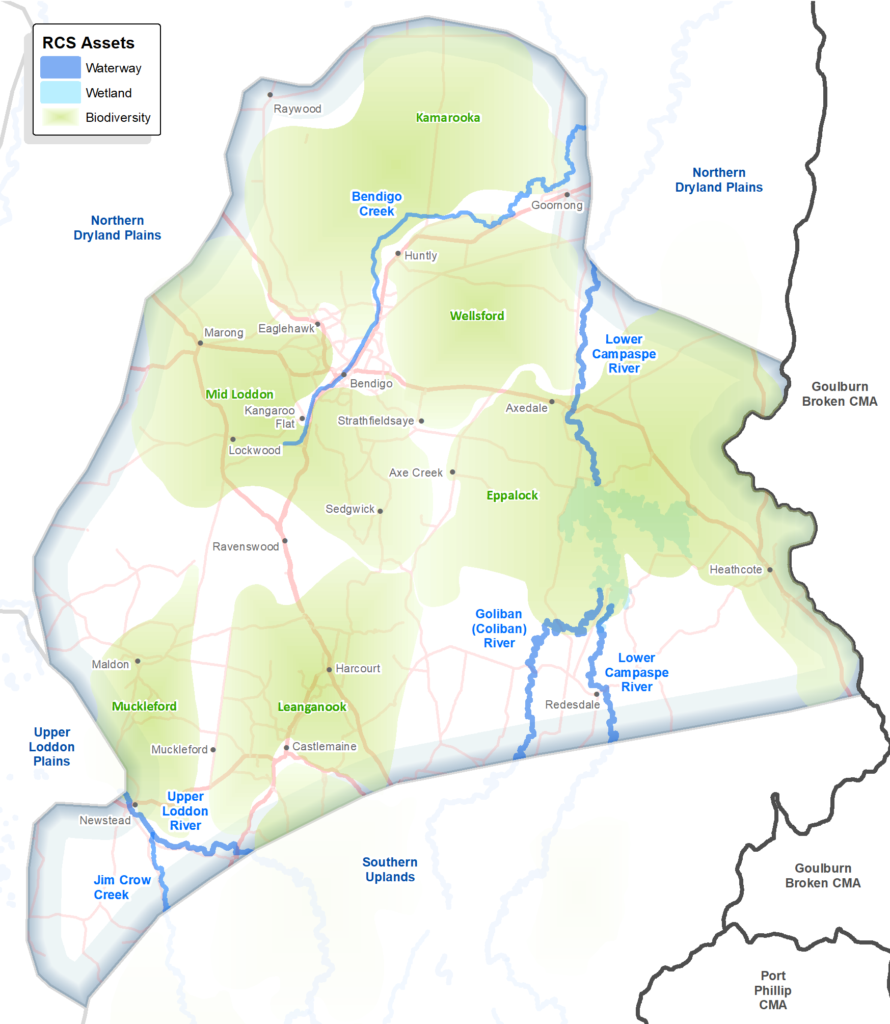Introduction
The Bendigo Goldfields includes the traditional lands of the Dja Dja Wurrung (west of the Campaspe River) and Taungurung (east of the Campaspe River) peoples.
This area, within the Goldfields bioregion, centred around the Calder highway and Bendigo, with residents more likely to travel to Bendigo for employment than Melbourne. Greater Bendigo is among the fastest growing regional Local Government Areas in Victoria, with a projected 1.6% increase in population between 2018-2036, which equates to an additional 37,700 people.
Affordability, compared to Melbourne, is driving population growth including in rural residential development around Bendigo. A strong demand for rural blocks is leading to a transition from farming to rural residential across this area. Managing this growth whilst protecting natural values and resources, in a changing climate, is a key challenge.
Bendigo is not only a popular place live, but also an important regional tourist destination, with many popular cultural attractions. In 2019, Bendigo was designated a UNESCO Creative City, in the category of gastronomy.
Box-Ironbark Forests and Woodlands once covered this landscape, but when gold was discovered in Bendigo Creek in 1851, attracting people from all over the word, the land was cleared, mined and developed. It produced the largest amount of gold in any field in eastern Australia. The area still includes large areas of remnant native vegetation dominated by Box Ironbark forests and including the Greater Bendigo National Park which is now jointly managed by Parks Victoria and Dja Dja Wurrung. Whilst these Forests and Woodlands support many unique and rare species they are generally in poor condition as a result of previous logging, gold mining etc.
This area spans the Loddon and Campaspe catchments, the upper sections of which are within a declared special water supply catchment area. It also includes Lake Eppalock which is an important irrigation and urban water supply.
When asked about their long-term vision during RCS renewal engagement, respondents from this Local Area spoke about; the importance of people connecting with and valuing nature, sustainable agricultural practices, working together to protect and restore waterways and habitat for future generations.

A snapshot
| Aspect | Description |
| Key partners | Traditional Owners: Dja Dja Wurrung and Taungurung DELWP, Parks Victoria, Trust for Nature and Agriculture Victoria Local Government: City of Greater Bendigo, Mt Alexander and Mitchell Shires. Landcare Networks: Upper Campaspe, Mid-Loddon, Mandurang Strathfieldsaye, Campaspe, Loddon Plains and Connecting Country Water corporations: Goulburn Murray Water (rural), Coliban Water (urban) |
| Socio-economic | Journey to work data (2011 census) shows 77% of City of Greater Bendigo residents works within their Shire, while 57% from Mt Alexander Shire residents work within their Shire and 22% work within neighbouring Shires (mostly CoGB). Areas where more than ten per cent of the workforce are employed in higher-skill service industries are concentrated around the Calder Freeway and some parts of Bendigo. Relatively high socio-economic advantage, except for some areas, notably the area west of Heathcote. |
| Bioregion | Goldfields |
| Native vegetation cover | Relatively high proportion of native vegetation. The land cover time series data for the period 2015-19 showed that native vegetation of some type, covered 59% of this area, which is the highest for the region. |
| Rural residential or agricultural | >80% of rural households are estimated to be rural residential (non-farmers) – as interpreted from ABS data. |
| Predominant agricultural land use | Predominantly dryland grazing. The Land Cover Time Series data for the period 2015-19 showed that pasture (not native) covered 27% of this area. Mostly smaller properties because of higher land prices due to rural residential demand. Some intensive animal industries situated north and west of Bendigo, with orchards around Harcourt. |
| Soil and land use overview | Apart from both historical and contemporary gold mining and exploration, the main land use is grazing, although this gives way to horticulture on the slopes of the granitic lands of the Harcourt granodiorite. Horticulture thrives within an array of colluvial fans (granitic outwash) comprising sand released through intense weathering of the granodiorite. The Harcourt Apple industry is a good example of the horticultural niche these landforms afford. This granitic terrain is very prone to both tunnel and gully erosion where it is intensely weathered. Proximity to Bendigo also raises issues with future potential for urban development and given the sensitivity of soils to erosive forces careful planning will be essential if further subdivision is to proceed. The Harcourt granodiorite intrusion is marked by a large metamorphic ridge featuring slates and quartzites known locally as the Big Hill Range. Some of the rugged higher relief lands remain under native forest, whilst in other areas it is grazed but experiences issues with shallow soils, low water holding capacity and soil acidity. |
Current and future challenges
The Bendigo Goldfields has and continues to face many challenges including:
- Population growth and demand for rural residential properties is putting pressure on water resources (e.g. small farm dams, bores) and biodiversity (habitat loss through clearing for development and to reduce wildfire risk) which will be exacerbated by climate change, and if not well managed could impact the significant environmental and cultural values of this area.
- Rural residential landholders don’t always have the skills, knowledge or time, to manage their land in a way that supports environmental values.
- Many smaller properties and landholders, means that engaging can be time consuming and this can be a barrier for some programs.
- The legacy of gold mining, including abandoned mining shafts, subsidence, contaminated land and groundwater, is what Dja Dja Wurrung call ‘upside down Country,’ and one of the goals of their Dhelkunya Dja, Dja Dja Wurrung Country Plan is to make this Country is healthy again.
- Groundwater contamination and rising levels below Bendigo is a major concern.
- Box-Ironbark Forests and Woodlands of this area are in poor condition, vulnerable to further drying under climate change, and require active restoration to halt further decline (refer Biodiversity theme page for more on this).
- Reduced water availability, as predicted with climate change, will mean less water for all users, and sharing benefits may be challenging, so building understanding and support for management strategies will be important.
- Increasing threat of wildfire due to climate change is a particular concern for this area.
Opportunities
Key opportunities for the Bendigo Goldfields include:
- New landholders present an opportunity to reinvigorate local community based NRM groups such as Landcare, to maintain strong community-based NRM organisations and momentum.
- There is generally a willingness amongst new rural residential landholders to protect and enhance the local environment.
- Transition of marginal agricultural land to rural residential use, presents opportunities to manage for conservation.
- Includes some areas with relatively high carbon sequestration potential as compared to the rest of the region which presents opportunities to leverage the carbon market for revegetation projects.
- Pilot projects are proposed to develop effective methods for holistic Box-Ironbark Forest and Woodland restoration.
- Increasing tree canopy cover in urban areas refer (Greening Greater Bendigo), will be important for community wellbeing, in our changing climate, as well as having environmental benefits.
- Water Sensitive Bendigo has provided a vision and transition plan on how Bendigo will deal with the future challenges in managing water over the next 50 years. An integrated approach across government agencies, Dja Dja Wurrung and the community is important to manage future water challenges in Bendigo. There is a greater focus on integrated water management, particularly in the urban areas, with opportunities to embed Water Sensitive Urban Design (WSUD) principles into future planning and implementation, examples include Reimagining Bendigo Creek and Wanyarram Dhelk.
Priority directions
Priority directions are covered in more detail under each theme – key priority directions for the Bendigo Goldfields include:
- Continue to build partnerships with Traditional Owners towards self-determined participation and leadership in water and biodiversity planning and management.
- Deliver targeted programs to build the capacity of rural residential landholders, to protect and enhance soils, water and biodiversity values.
- Build community awareness and capacity around the management of water resources and waterways, in the context of climate change.
- Maintain and improve the quality of our remnant native vegetation and habitats, considering climate resilience, with a focus on RCS priority biodiversity assets.
- Collaborate to maximise the potential of carbon market investment, to contribute to land, water and biodiversity outcomes.
- Undertake pilot projects across the region, to develop effective methods for holistic Box- Ironbark Forest and Woodland restoration, to inform and broaden this practice and increase investment in their management.
- Continue to collaborate to implement integrated water solutions in urban areas by applying Water Sensitive Urban Design principles.
- Continue to support the collaborative development and implementation of Integrated Catchment Management projects.
And those relevant to the regional community generally, include:
- Build capacity, networks and leadership to enable community led climate solutions for land, water and biodiversity management.
- Support, improve and expand the environmental volunteering sector, including Landcare, to enable adaptation to demographic shifts, to continue their important role in NRM.
- Enable, improve and promote opportunities for communities to connect with nature, in both urban and rural settings, for wellbeing, to build awareness and appreciation, and inspire action.
- Support schools and young people to participate in programs that increase their knowledge and awareness of natural resource management.
- Continue to support integrated citizen science programs that engage community and provide useful targeted data to inform water, land, climate and biodiversity programs.


